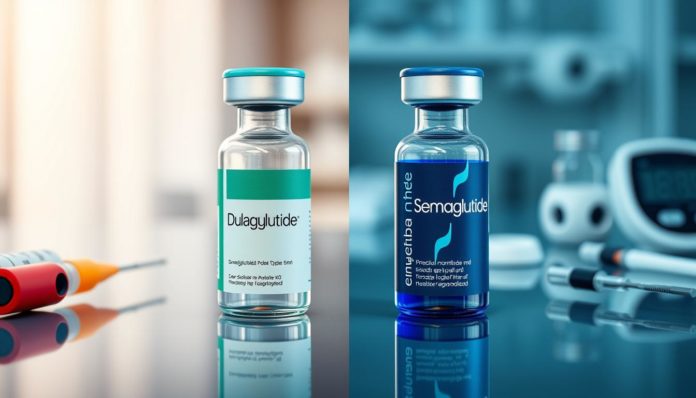Nearly 34.2 million Americans have diabetes, most of them Type 2. Effective treatments are critical. Dulaglutide and Semaglutide are important for managing this common condition. They are GLP-1 receptor agonists that help control blood sugar and may also benefit the heart.
Dulaglutide and Semaglutide serve the same purpose but differ in a few ways. This article explores these diabetes medications in detail. It highlights their dosages, how you take them, and their health outcomes.
Overview of GLP-1 Receptor Agonists in Diabetes Treatment
GLP-1 receptor agonists are leading the way in diabetes care. These medicines help keep blood sugar levels just right. They also bring extra benefits that make blood sugar control better and help patients feel well.

What are GLP-1 Receptor Agonists?
Dulaglutide and Semaglutide are types of GLP-1 receptor agonists. They are injectable drugs for type 2 diabetes. These drugs act like the GLP-1 hormone, which helps increase insulin when blood sugar is high. This improves the body’s response to insulin, especially after eating.
How They Help in Diabetes Management
GLP-1 receptor agonists reduce glucagon, which can raise blood sugar. Also, they slow the emptying of the stomach. This means less sugar in the blood after meals. Their action helps level out blood sugar changes. Plus, they help people feel fuller, which supports weight loss. So, they have several ways of improving blood sugar control in diabetes care.
Mechanisms of Action: Dulaglutide vs Semaglutide
Understanding how Dulaglutide and Semaglutide work is key for Type 2 diabetes treatment. These drugs, known as GLP-1 receptor agonists, have important roles. They boost insulin production, cut down glucagon output, and slow stomach emptying. We’ll look into how they help manage Type 2 diabetes.

Insulin Secretion Control
Dulaglutide and Semaglutide make the pancreas produce more insulin when blood sugar is high. This lowers blood sugar, aiding in Type 2 diabetes treatment. By increasing insulin when necessary, these drugs keep blood sugar stable.
Glucagon Suppression
People with Type 2 diabetes often have too much glucagon, which raises blood sugar. Dulaglutide and Semaglutide reduce glucagon’s output. This helps control blood sugar more effectively.
Gastric Emptying Delay
Dulaglutide and Semaglutide also slow down how fast food leaves the stomach. This helps keep post-meal sugar levels in check. By delaying food’s move to the intestine, they aid in blood sugar management and can help with weight loss by lowering caloric intake.
Dosing and Administration
It’s vital to get the dosage and administration right with diabetes medicines. We’re looking into Dulaglutide and Semaglutide, two injectables for diabetes.
Dulaglutide Dosing Guidelines
Dulaglutide starts at 0.75 mg once a week. It might go up to 1.5 mg for better blood sugar control. Make sure to follow your doctor’s advice on dose changes. You use a prefilled pen for this shot.
Semaglutide Dosing Guidelines
Semaglutide starts at a low dose of 0.25 mg weekly to reduce stomach side effects. After four weeks, it can go up to 0.5 mg and maybe even 1 mg if needed. Like Dulaglutide, you use a prefilled pen for Semaglutide.
Comparison of Administration Methods
Dulaglutide and Semaglutide both are taken once a week, which makes them handy. They use a pen injector for the shot under the skin.
You must keep Dulaglutide in the fridge until you use it the first time. Then, it can stay out up to 14 days. Semaglutide also needs to be cool before first use. You should throw away the Semaglutide pen 56 days after opening, even if it’s not empty. Both are easy to use, but remember to store them right so they work well.
Efficacy in Blood Sugar Control
Both Dulaglutide and Semaglutide have shown great results in blood sugar control. They have proven their worth in clinical studies. Let’s delve into their impact on Hemoglobin A1c reduction. We will also explore how many patients hit their sugar targets.
Hemoglobin A1c (HbA1c) Reduction
Hemoglobin A1c reduction is key in managing diabetes. Dulaglutide and Semaglutide both lead to significant HbA1c reductions. Semaglutide often has a bit of an edge, though. This makes it a go-to for patients wanting strong glycemic control.
Percentage of Patients Achieving Glycemic Control
Both drugs do well in helping patients reach glycemic control goals. More people reach their target HbA1c levels with Semaglutide than with Dulaglutide. Keeping blood sugar at these levels is vital for managing diabetes in the long run.
| Medication | HbA1c Reduction | Patients Achieving Glycemic Control (%) |
|---|---|---|
| Dulaglutide | 1.2% – 1.6% | 70% |
| Semaglutide | 1.5% – 2.0% | 80% |
In the end, both Dulaglutide and Semaglutide are excellent at helping with diabetes. They aid in cutting down Hemoglobin A1c. Also, they increase the number of patients who successfully manage their sugar levels.
Side Effects and Precautions
Understanding the side effects and precautions of diabetes medications like Dulaglutide and Semaglutide is crucial. They are effective in managing type 2 diabetes but carry risks and benefits. Knowing what to expect is vital for anyone using these medications.
Common Side Effects
Gastrointestinal problems such as nausea, vomiting, and diarrhea are common with Dulaglutide and Semaglutide. Some patients may feel abdominal pain or eat less. Usually, these side effects lessen as your body gets used to the medicine.
Rare but Serious Risks
There are serious risks, though they are rare. A big worry is the chance of getting thyroid tumors, including a type called medullary thyroid carcinoma (MTC). If you or your family have a history of MTC or a condition called MEN 2, you should not take these drugs. For more on these risks, check the Mayo Clinic’s guidelines.
Precautions for Use
Taking certain precautions with these medications is necessary. Regular check-ups ensure they work safely and effectively. People with diabetic eye disease should be cautious with Semaglutide because of possible eye problems.
Being informed about side effects of Semaglutide and diabetes medication precautions is key. Talking with your doctor and staying updated helps manage your diabetes better.
Impact on Weight and Cardiovascular Health
GLP-1 receptor agonists like Dulaglutide and Semaglutide are vital for weight control and heart health. This is especially true for those treating Type 2 diabetes.
Effects on Body Weight
Semaglutide often leads to greater weight loss than Dulaglutide. This benefit is crucial for people trying to manage their weight while dealing with Type 2 diabetes. Helping with weight control plays a key role in treating diabetes.
Cardiovascular Benefits
Cardiovascular health is key for people with Type 2 diabetes. Both drugs help, but Semaglutide is better at lowering the risk of heart problems. It is especially good for those with existing heart disease. So, Semaglutide might be the top choice for those focusing on heart health.
| Medication | Weight Management | Cardiovascular Health |
|---|---|---|
| Dulaglutide | Effective | Beneficial |
| Semaglutide | More Effective | More Substantial |
Dulaglutide/Semaglutide: Contraindications and Warnings
It’s key to know the contraindications and warnings for dulaglutide and semaglutide when treating diabetes. These medications have important precautions. For example, they’re not for patients with a history of thyroid cancers or certain genetic conditions because of a cancer risk found in studies.
For semaglutide, eye condition monitoring is needed. Dulaglutide doesn’t have this warning. Healthcare providers must balance the benefits and risks to ensure the best outcomes for patients.
Here are some specific warnings to be aware of:
| Medication | Contraindications | Warnings |
|---|---|---|
| Dulaglutide | History of MTC, MEN 2 | Risk of thyroid C-cell tumors |
| Semaglutide | History of MTC, MEN 2 | Risk of thyroid C-cell tumors, retinopathy monitoring |
Patients need to fully understand these warnings. This helps them make informed choices about their diabetes treatment. Talking about Dulaglutide safety with experts is wise. It ensures the treatment matches the patient’s health needs and goals.
Cost and Insurance Considerations
Managing diabetes costs includes understanding medication expenses. Dulaglutide and Semaglutide are effective but can cost $900 to $1000 monthly. Investigating the costs and finding financial help is key to reducing the burden of these treatments.
Price Comparison
The price for diabetes meds like Dulaglutide and Semaglutide is high, with costs around $900-$1000 monthly. Prices can vary by pharmacy, location, and distributor deals. This means shopping around might save some money.
Insurance Coverage
Insurance is vital in lowering diabetes medication costs. Coverage varies, so checking your plan details is essential. It’s wise to talk to your insurance provider to understand your benefits fully.
Comparing insurance options can also help find the best deal for diabetes care. This could lead to significant savings on your medication.
Available Coupons and Assistance Programs
There are also assistance programs and coupons to help with costs. Companies like Eli Lilly and Novo Nordisk offer help for their medications. These options can greatly reduce how much you pay, depending on your eligibility and the medication.
FAQ
What are GLP-1 Receptor Agonists?
GLP-1 Receptor Agonists help manage Type 2 diabetes. They work by enhancing insulin production and suppressing glucagon. This helps control blood sugar and may aid in weight loss.
How do GLP-1 Receptor Agonists help in diabetes management?
They stimulate insulin and reduce glucagon, minimizing hypoglycemia risk. They also slow digestion, lowering post-meal sugar spikes. This aids in weight management for diabetics.
How do Dulaglutide and Semaglutide control insulin secretion?
Dulaglutide and Semaglutide boost insulin production when blood sugar is high. This ensures enough insulin to lower blood sugar after eating.
How do these medications suppress glucagon?
These drugs decrease glucagon, a hormone that raises blood sugar levels. This helps keep blood sugar levels stable.
What is the impact of Dulaglutide and Semaglutide on gastric emptying?
Both drugs slow stomach emptying. This reduces sugar spikes after meals and can help with weight loss and blood sugar control.
What are the dosing guidelines for Dulaglutide?
Dulaglutide is given once a week by injection, starting at 0.75 mg. Dosage may increase based on blood sugar levels and doctor advice.
What are the dosing guidelines for Semaglutide?
Semaglutide is also a weekly injection, beginning at 0.25 mg. The dose is adjusted to control blood sugar effectively.
How do the administration methods of Dulaglutide and Semaglutide compare?
Both are given via pen injectors. It’s important to follow the instructions with each drug.
How effective are Dulaglutide and Semaglutide in reducing HbA1c levels?
Both lower HbA1c, with Semaglutide slightly more effective in trials. They help maintain controlled blood sugar.
What percentage of patients achieve glycemic control with these medications?
Many patients reach their HbA1c goals with these treatments, showing good diabetes management.
What are the common side effects of Dulaglutide and Semaglutide?
Side effects include nausea, vomiting, and diarrhea. These often decrease as the body adjusts.
What are the rare but serious risks associated with these medications?
They may cause thyroid tumors. People with certain thyroid conditions should avoid them. Semaglutide users should watch for diabetic eye issues.
What precautions should be taken when using Dulaglutide or Semaglutide?
Talk to your doctor about your medical history, especially thyroid or eye issues. Regular check-ups and correct dosages are key.
How do Dulaglutide and Semaglutide impact body weight?
Both can lead to weight loss by slowing digestion. Semaglutide is slightly more effective in this regard.
What cardiovascular benefits do these medications offer?
They may reduce heart disease risks, with Semaglutide showing greater benefits for heart patients.
What are the contraindications and warnings for using Dulaglutide and Semaglutide?
Avoid them if you have certain thyroid conditions. Semaglutide may also pose risks for eye health, requiring monitoring.
What is the cost comparison between Dulaglutide and Semaglutide?
Both are expensive, costing around 0-00 monthly. Costs vary by insurance and program assistance.
How does insurance coverage factor into the cost of these medications?
Insurance can greatly reduce costs. Check your plan’s details and ask about co-pay options.
Are there any available coupons or assistance programs for these medications?
Yes, coupons and assistance programs can help lower costs. Talk to healthcare providers or pharmacists for details.


